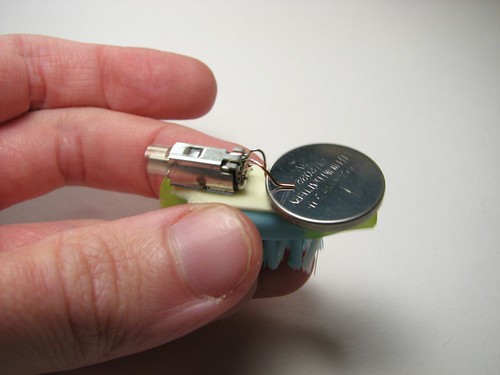Activity: The BristleBot
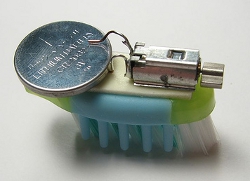 (Activity courtesy of Windell H. Oskay of Evil Mad Scientist Laboratories.)
(Activity courtesy of Windell H. Oskay of Evil Mad Scientist Laboratories.)
Level: All levels, depending on application.
Cost: Around $5 per BristleBot
Overview
BristleBots are one variety of the popular vibrobot, a simple category of robot controlled by a single vibrating motor. This BristleBot is made from a toothbrush and a few low-cost materials and can easily be modified for additional challenge.
Classroom Application
The BristleBot activity serves as a good opener to lessons on electricity, motion, or robots. Robotics and physics clubs may also find it a fun after-school activity.
Using the BristleBot in a classroom or extra-curricular setting will vary, based on grade level. Teachers can make one and bring it to class to demonstrate for younger students. Older students can build the BristleBots on their own. Or, teachers may assemble and distribute the materials for a guided class activity. Depending on the age group, and for safety, teachers may wish to solder the copper wire leads onto the motor ahead of time.
Materials
A flat place, preferably with walls will be needed to run the BristleBots. Scissors and a cutting tool will be needed for construction. Each individual BristleBot will require:
- A toothbrush with even, angled bristles
- A vibrating pager motor/other tiny motor with an unbalanced output shaft
- Foam tape
- An alkaline or lithium coin cell or watch battery (1.5 V or 3 V)
- Copper wire
- Optional: a soldering iron to connect the copper wire to the motor.
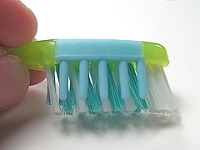 The starting point is, of course, the toothbrush. A good one has uniformly angled bristles. If the bristle length is nonuniform, it may take scissors to make the bristles all the same. Cut off the handle of the toothbrush, leaving only a neat little robotics platform.
The starting point is, of course, the toothbrush. A good one has uniformly angled bristles. If the bristle length is nonuniform, it may take scissors to make the bristles all the same. Cut off the handle of the toothbrush, leaving only a neat little robotics platform.
Next, a vibrating pager motor or other tiny motor with an unbalanced output shaft is needed. They can be purchased on eBay for a few dollars or here, for example.
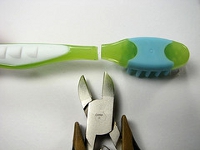
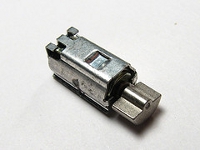
The kind used for this example run on almost any common voltage: probably a range of 1-9 V. As a power source, use an alkaline or lithium coin cell or watch battery, either 1.5 V or 3 V.
To hook the motor to the battery, short copper wire leads were soldered to the motor terminals, but any sturdy method of securing them is sufficient.

The last substantial ingredient is foam tape, used to hold the motor in place atop the toothbrush robotic platform.
Procedure
1. Cut off the handle of the toothbrush to produce the robotics platform.
2. Attach short copper wire leads to the motor, either soldering them to the motor terminals, or securly affixing them with heavy tape.
2. Apply a small piece of foam tape to the top of the toothbrush robotic platform to hold the motor in place.
3. Attach the motor to the foam tape. The tape provides a spacer so that the rotating weight does not hit the toothbrush head. It also provides a strong, flexible connection to the base that is able to handle the severe vibration that this robot experiences. 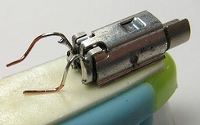
a. Do not stand the battery on end, as it will be insecure and fall off easily.
b. Instead, bend one of the leads flush with the foam tape, so that you can stick the battery to the foam tape, as well, and still make an electrical connection. 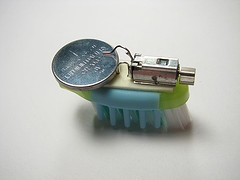
c. The other lead contacts the other side of the battery, and the motor can run.
4. Refinements: The completed BristleBot is now running and ready for action. When it is set down, it may tend to steer left or right.
Battery and motor placement, bristle shape, and even one stray bristle can interfere with the motion. Encourage students to experiment with each of these elements, to get their Bristlebot to run straight. Motor rotation direction can also influence the behavior, so it may help to flip the battery upside down.
Once the BristleBot is going straight, it will continue on until it hits something, which will turn it and send it off in another direction. Several BristleBots can race across a room at once, creating a fun group activity.
Watch a video explaining the procedure:
Activity Extension:
Engage students in a discussion of their procedure and techniques, to explore difficulties encountered, as well as ingenious solutions.
Then, challenge them to consider — and devise — design modifications. What would happen if the toothbrush bristles were not straight? What could be done to the BristleBot to make it go in circles? Could a similar vibrobot be made from a flat-topped dust broom or a hair comb?
Other varieties of vibrobots include the mint-tin version as seen in Make Magazine, and the kid’s art bot: a vibrobot with pens for feet.
All images were posted in Flickr Commons, licensed Creative Commons Attribution 2.0 Generic, and are from Windell H. Oskay. BristleBot blog post on the Evil Mad Scientist Laboratories.
(YouTube video here.)The BristleBot is our take on the popular vibrobot, a simple category of robot that is controlled by a single vibrating (eccentric) motor. Some neat varieties include the mint-tin version as seen in Make Magazine (check the video), and the kid’s art bot: a vibrobot with pens for feet.
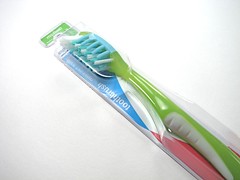 |
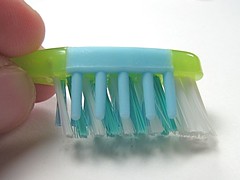 |
| The starting point is of course the toothbrush. We need one that has more-or-less uniformly angled bristles. (While it may be possible to take one with straight bristles and bend them to suit, I haven’t tried.) If the bristle length is nonuniform (as it is here), it may take scissors to make the bristles all the same. | |
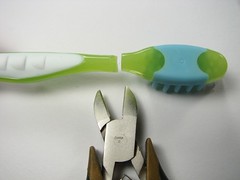 |
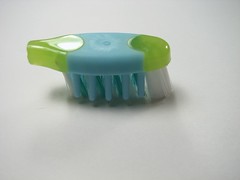 |
| Cut off the handle of the toothbrush, leaving only a neat little robotics platform. | |
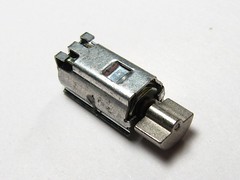 |
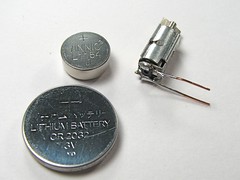 |
| Next, we need a vibrating pager motor or other tiny motor with an unbalanced output shaft. If you should happen to find a small enough motor you can always add the weight yourself, but usually motors this size are made for pagers anyway. I got mine on eBay for a few bucks; you can also get them here, for example.
The kind that I got are happy to run on almost any common voltage– probably a range of 1-9 V. As a power source, you can use an alkaline or lithium coin cell or watch battery, either 1.5 V or 3 V. To hook the motor to the battery I soldered short copper wire leads to the motor terminals. |
|
 |
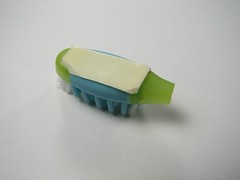 |
| The last substantial ingredient is some foam tape. Apply a small piece to the top of the toothbrush robotic platform, which will be used to hold the motor in place. | |
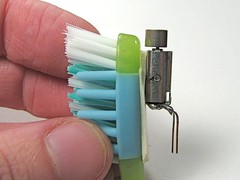 |
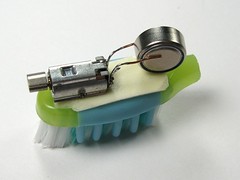 |
| Attach the motor to the foam tape. The tape provides a spacer so that the rotating weight does not hit the toothbrush head. It also provides a strong, flexible connection to the base that is able to handle the severe vibration that this robot experiences. A first approach to hooking up the battery might be to stand it on end. However, the battery itself is not held in place very well this way and will fall out shortly. | |
 |
 |
| A better method is to bend one of the leads down flush with the foam tape, so that you can *stick* the battery to the foam tape as well and still make an electrical connection. The other lead contacts the other side of the battery, and the motor can run.
The completed BristleBot, running and ready for action. When you set one down, you may notice that it tends to steer left or right. We have found that battery and motor placement, bristle shape (one stray long bristle can interfere with the motion, and motor rotation direction all influence the behavior- so be sure to try flipping the battery upside down if you have trouble getting yours to go straight. Now and for the record, this is one of many different kinds of vibrobots– there are a lot of other designs out there if you go and look. We have heard of and seen many other vibrating robots, and we know that even using a brush with angled bristles for propulsion has been done before. However, this particular miniature implementation may be unique, and is certainly fun. Very few robots that you can build so easily are so rewarding. With the right parts, you can make one in a few minutes. It might be great fun to make a bunch of them to race them competitively. |
|
Filed under: Class Activities, Grades 6-8, Grades 9-12, Grades K-5
Tags: Building robots, Class Activities, DIY, Lesson Plan, Robotics









